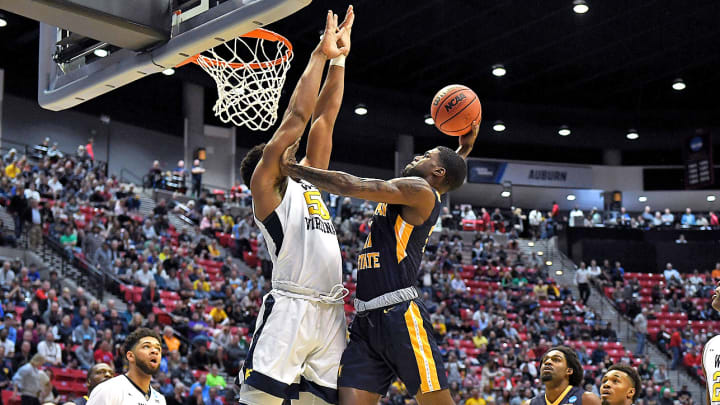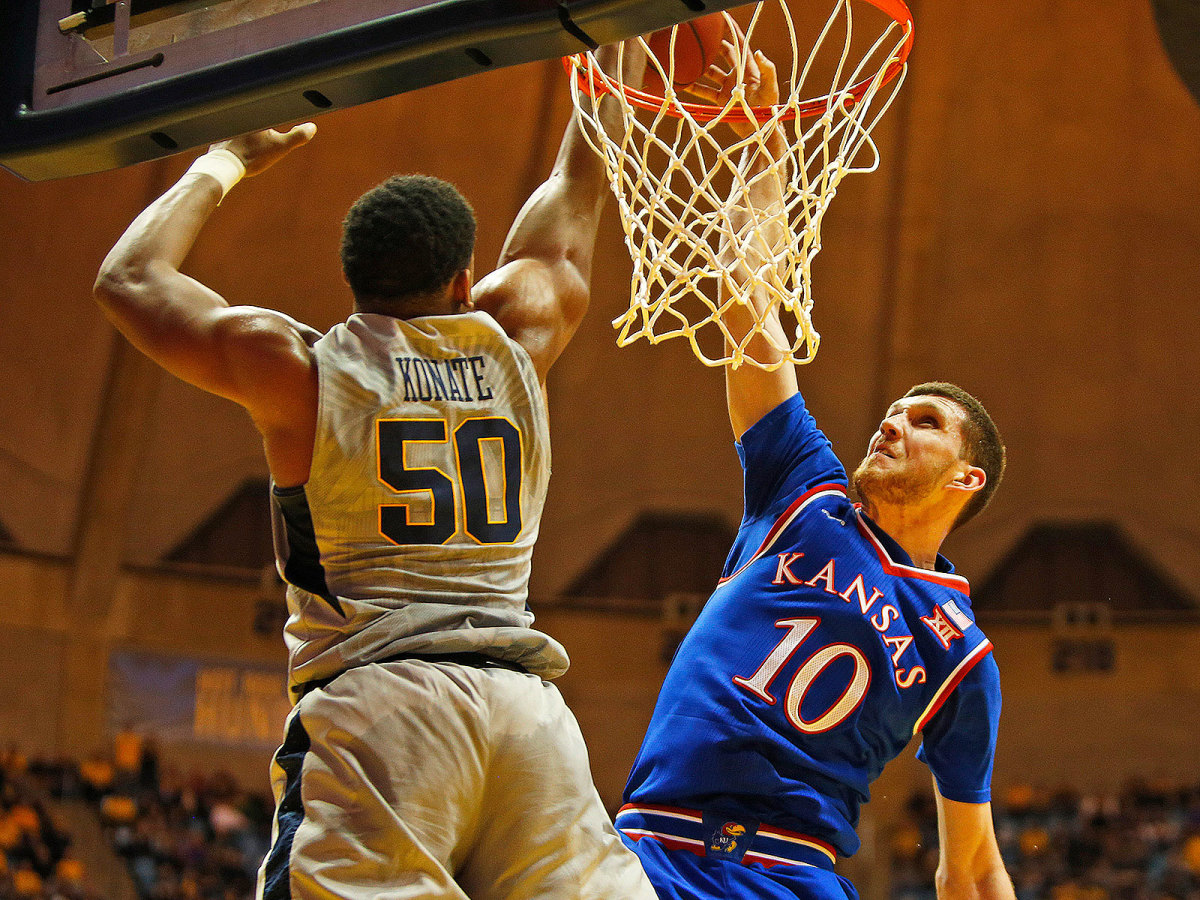The Art of Shot Blocking: How WVU's Sagaba Konate Became a Master of Rejection

The legend of Konate took flight the way many things do in sport these days.
Via gif.
Actually, in Konate’s case, it started with a series of gifs that came in a flurry on a Monday night in Morgantown when No. 10 Kansas visited No. 6 West Virginia. Sagaba Konate’s first rejection came on a fast break 38 seconds into the game. Less than 30 seconds later, Konate swatted another Jayhawks lay-up attempt away. Then, on a two-on-one fast break, Svi Mykhailiuk tried to posterize the sophomore center who was positioned under the basket and met Mykhailiuk at the rim with a two-handed block volleyball style stuff. Mitch Lightfoot tried Konate two minutes later and he, too, got denied. His fifth of the first half came when KU’s Marcus Garrett soared in from the right wing only to get shut down with another two-handed block.
Kansas players shouldn’t feel deflated. Konate, as the last line of defense to the vaunted Press Virginia attack, has done similar to the rest of college basketball as the Mountaineers roared into the Sweet 16 after blowing out both Murray State and Marshall. His 3.3 blocks per game ranks third in the country. It’s an eye-opening stat especially considering that he is the shortest player among the nation’s leaders in blocked shots.
The Sweet 16 May Be Set, but There's Nothing Concrete About This NCAA Tournament
WVU assistant coach Erik Martin, aka the “Sags Whisperer,” who works with the Mountaineer big men, calls Konate a unique talent. A member of the Cincinnati 1992 Final Four team, Martin said he’s never been around a player with such uncanny timing as a shot-blocker.
"He’s explosive but we’ve had better athletes,” Martin says, adding that Konate doesn’t have the freak of nature type of athleticism that former Cincy big man Kenyon Martin had. “Kenyon had really elite (explosion). If you blink your eyes he’s really up above the rim. I’ve been around and played all over the world, I’ve never seen anyone who had a quicker jump. Sags isn’t like that. He’s gonna gather himself. He’s bigger than Kenyon and he has huge, strong mitts. I’ve never seen anybody block two-hand shots like that. I wasn’t around with the Bill Russell era. It’s one thing to block a guys dunk but to do it with two hands, that’s just something you don’t see. You know how much confidence you have to have to try and do that? A split second earlier or later and you’re getting dunked on.
"Sags’ blocks are at the rim which you rarely see anywhere because guys are always worried about getting dunked on. He’s figured out a way to meet guys at that time."

Asked how Konate’s figured this out, Martin traces it back to the sophomore’s upbringing in Mali, Africa. Konate grew up playing soccer and said he only started playing basketball in 2014.
"Last year, a guy from Texas (Jarrett Allen) dunked right on top of Sags,” says Martin. "It was like ESPN’s Dunk of the Week. It didn’t bother him one bit. Most kids who are raised in America would be (crushed).”
Konate doesn’t get hung up dreading some kind of self-esteem stigma.
“For me, I just don’t really get into those things. ‘Oh, they’re gonna dunk on me and I’m gonna be on SportsCenter.’ I don’t really care about that,” he says. "It’s just a mindset. Whether you’re gonna get dunked on or you’re gonna block their shot, it’s out of my mind if they dunk on me. It’s behind me. I got dunked on so many times last year. I learn from it. This year, it’s a lot less.
"That was how I was raised. I grew up with 13 brothers and sisters. It was more competitive. My brother and my dad always told me, the past is the past. You just gotta keep it going forward."
Konate has come a long way indeed.
Like Jevon Carter, who last season won national defensive player of the year honors, Konate came to Morgantown as an unheralded recruit. Like five of his brothers, Konate—one of 14 children—came to the U.S. to pursue education and basketball opportunities. He played at a Class A high school near the Pennsylvania-Ohio border.
“There weren’t a whole lot of people recruiting him,” says Larry Harrison, the WVU assistant who recruited him. "He played for a local AAU team, played for a small high school, so he didn’t have a lot of exposure. Wichita State, Penn State recruited him. Pitt just didn’t recruit him. We had friend who went to Walsh College when Huggs (Bob Huggins) was the coach there. He called me and said there was a kid that I needed to take a look at.”
After Harrison returned from watching Konate play, Harrison admitted to Huggins that he wasn’t sure how good the prospect was. But he was big and he was very athletic and they should keep recruiting him.
"In high school he wasn’t blocking shots like this, but now the way he’s blocking shots, it’s become his art,” says Harrison.

Konate’s development is rooted in the same place that many other Mountaineer sleeper success stories are—the weight room. In less than two years, he’s re-shaped his physique and packed on almost 20 pounds. He’s now 258 pounds.
"I remember giving him 30-pound dumbbells and I thought he was gonna drop 'em on his face,” says Andy Kettler, WVU’s strength coach. "The idea was simple. Teach accountability. Teach him to work hard. Just keep it simple. Take a handful of simple things and build on it.”
Konate now can do single-arm bench press with 115-pounders for sets of 10. Kettler says Konate’s vertical jump also is well over 35 inches.
"My thing to him is he’s 6'8", not 7'0". 'You need to become the strongest player in the country so that you can separate yourself against those 6'11" guys,' because he is our center.”
Fran Fraschilla was calling that Texas-WVU game last season when Konate was on the wrong end of ESPN’s Dunk of the Week.
"That was me,” says Fraschilla. “I was screaming, 'THE DUNK OF THE YEAR! THE DUNK OF THE YEAR!!’” But it just rolled off (Konate’s) back. He has a pride in blocking shots. If you dunk on me, great. It’s very similar to what we remember about (Dikembe) Mutombo and (Patrick) Ewing. It’s not something to show somebody up. It’s more this is my thing. Every great shot blocker has to have pride in blocking shots. It becomes part of their identity. ‘You may score on me but I’m waiting for you to come at me again.’”
Fraschilla also credits Martin—the "Sags Whisperer" for also helping develop him into a capable low-post scorer and managing his emotional on-court fire in a young player that has a bit of a temper.
Fraschilla, who has spent 39 years in coaching and broadcasting basketball, says there are four elements to what he describes as the art of shot-blocking.
• Pride
• Body Positioning
• Timing
• Instinct
In regards to Konate’s body positioning, Fraschilla has observed that the WVU big man, if he’s not going for the two-handed rejection, always tries to block the ball with his inside hand (the one closest to the rim) depending on which side the offensive player is coming from, to keep his body away and eliminate body contact. From a timing perspective, Konate never leaves his feet before the offensive player does, Fraschilla says. “He has a great ability to stay vertical.”
Despite the penchant for two-handed blocks, Konate never played volleyball growing up.
"My teammates say, 'Sags you block the ball and it goes out of bounds. You gotta grab it or tip it to us.’ I said, ‘Oh, yeah, that sounds really good.’”
Konate says he likes to watch film of Ben Wallace, an undersized post player who became a four-time NBA Defensive Player of the Year. Asked where his timing comes from, Konate says he just doesn’t know.
“It might be natural," he says. "It’s just a mindset."
